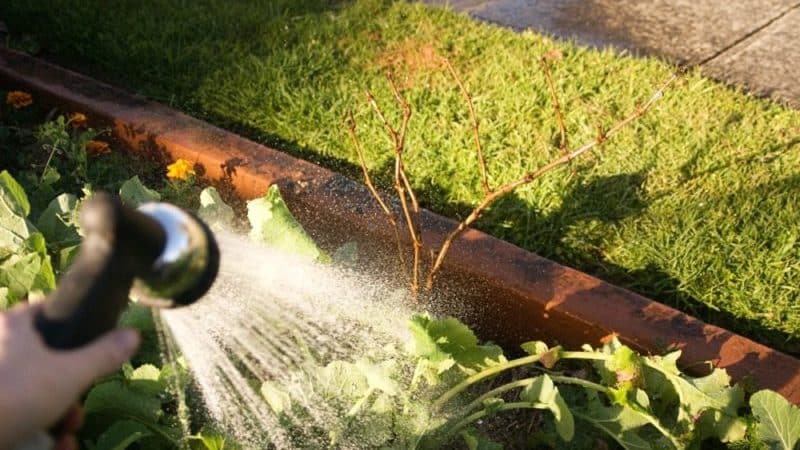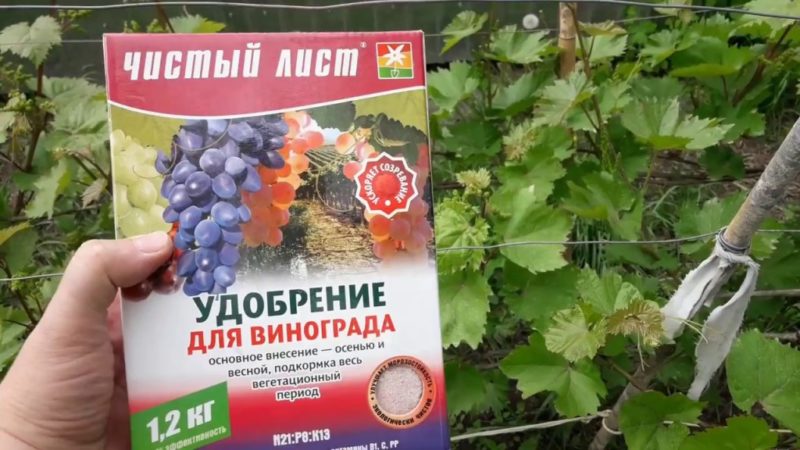How to water and feed grapes in spring: instructions for beginners
Grapes require special attention throughout the growing season. In the fall, it is prepared for cold weather, and in the spring, favorable conditions are created for abundant fruiting. Spring watering and fertilizing must be consistent and balanced, otherwise the plant will become sick or develop slowly. We’ll look at how to properly moisturize and feed grapes in spring in this article.
The beginning of spring watering of grapes
The first watering of the grapes is carried out at the end of March or beginning of April, the earth should warm up to +5°C. This type of watering is called moisture-charging because it replenishes the lack of water in the soil after winter. The second watering - vegetative watering - is aimed at stimulating the development of buds. It is carried out 2-3 weeks after the first. Experienced gardeners recommend paying attention to the timing of watering depending on the growing region. As a rule, in the southern regions the plant is watered 1-2 weeks earlier, since the snow melts there earlier and warm weather sets in.

Grape feeding
Grapes are demanding of fertilizers, so they need a balanced diet throughout the growing season.. If you don't make feeding in spring, the plant develops slowly, often gets sick, the fruits grow insipid and small.
There are several opinions about spring feeding. Some winegrowers believe that the first fertilizer is applied before the bushes open (around the end of March or early April), others - after.The second feeding is carried out before flowering begins, approximately in the middle or end of May.
Basic rules for conducting procedures

When watering, agronomists recommend paying attention to grape sort - some need constant moisture, others are drought-resistant. The quality of the soil and the climatic features of the area are also taken into account. For example, in arid regions, sandy and sandy loam soils predominate; it rarely rains, which means that the grapes need constant moisture.
When applying fertilizers, maintain a balance between organic and mineral compounds. Too much nutrition is just as dangerous as too little. For example, if you do not follow the rules for applying nitrogen fertilizers, the shoots and leaves will dry out and the formation of bunches will decrease. If complex fertilizers are applied incorrectly, the taste of the fruit and its appearance will deteriorate.
Moisten and feed the grapes early in the morning or in the evening, when there is no sun. Otherwise, the water will quickly evaporate and the plants will be left with sunburn.
First watering of grapes in spring
How often to water grapes and how much water to use? The first watering is carried out before the sap begins to flow. One bush requires 10-15 liters of water. Use warm water to speed up the development of shoots. For irrigation, the method of underground irrigation is used or water is poured from above onto the roots.

Second and subsequent
The grapes are watered a second time 14-21 days before flowering. In central Russia, this period begins around mid-May. An adult plant uses 20 liters of water. If grapes are grown on a plantation, per 1 sq. m takes about 70 liters. Before the procedure, study the weather forecast for the week ahead. If frosts are expected, watering is postponed.This is especially true for the Urals and Siberia - regions with an unstable climate.
In subsequent times, the grapes are moistened during bud break, after flowering and at the time of berry growth. 3-4 weeks pass between procedures. About 10 liters of water are consumed per bush - the volume depends on the age of the grapes and weather conditions. If it rains frequently, the amount of water is reduced.
Attention! You cannot water the grapes before flowering or during flowering - the flowers will fall off. Also, summer residents stop moistening three weeks before harvesting - water provokes cracking of the berries, the grapes lose their taste and appearance.
Signs of overwatering and how to avoid them

If the soil is waterlogged, nutrients are washed out of it, which negatively affects crop yields. The soil loses oxygen, causing the roots to rot. All this leads to fungal and bacterial diseases, cracking of fruits, and loss of taste. Therefore, before watering the plant, it is recommended to inspect the soil. If it is clear that the soil is still wet, watering is postponed for several days.
Signs of excess water indicate:
- slow growth of shoots and berries;
- wilting of leaves;
- unsaturated grape color;
- small bunches;
- watery texture of grapes.
Watering methods
There are surface and underground irrigation. Surface is used more often by amateur gardeners. Water moistens only the top layer of soil, no more than 50 cm. Surface irrigation methods:
- Drip — tubes, taps and drippers are installed along the vineyard. Water enters the reservoir, heats up and flows through tubes to each plant. Through such a system, the soil is moistened gradually, there is no sudden temperature change. The method is also appreciated for its economical water consumption.The drip system is also convenient to use for applying liquid fertilizers. The disadvantage of this method is the complexity of the design.

- Watering the holes. 5-6 holes are made near each bush. On the one hand, it is simpler than drip irrigation, but it requires more water. Summer residents make holes in a circle so that the roots are moistened evenly. This method is convenient because for each grape variety you can set a certain volume of water.
- Watering in trenches. Gardeners make trenches 20 cm deep and 40 cm wide between the rows. They dig them at a distance of 50 cm from the bush. This method is suitable for adult and young plants; it evenly moistens the top layer of soil. However, water evaporates quickly and is wasted uneconomically.
Underground irrigation

Thanks to underground irrigation, water reaches the deep layers of the soil. Water does not evaporate from the soil surface and goes directly into the root system. Thanks to this, the risk of developing diseases is reduced, weeds that appear in damp soil grow less, the roots grow and become more resilient, and the risk of fruit cracking is reduced.
Types of underground irrigation:
- Using horizontal pipes. At a depth of 70 cm, install a plastic tube with holes. Water heated in the sun is poured into a container, from where it is distributed through pipes. The holes should be spaced 1 m apart.
- Using bottles. Plastic bottles with holes are placed around the stem at a distance of 1 m from each other. Depth - 50-70 cm underground. Water enters the bottle through a garden hose. The method is easy to implement and does not require costs.
To ensure that grapes grow healthy, gardeners alternate underground and surface watering.The main thing is to monitor the condition of the soil and pay attention to the appearance of the plant.
What to feed in spring
Without timely mineral and organic fertilizers, it is impossible to obtain a tasty grape harvest. Some microelements are responsible for the marketability of fruits, others for the growth of young shoots and plant immunity. Winegrowers use purchased products and folk recipes.
Purchased funds
The first feeding is carried out 7-10 days before flowering. During this time, the grapes have already woken up after winter, and they need strength to develop fruits. Effective commercial fertilizer - “Universal Biochelate”. It increases productivity by 30%, promotes fruit ripening, and prevents the development of fungal diseases. In addition, it reduces the level of nitrates in fruits and increases the shelf life of the crop. Contains nitrogen, phosphorus, zinc, boron, copper and potassium. Sold in liquid form, the working solution is easy to prepare.
 Ready-made fertilizer “Izyuminka” is used for table and industrial grape varieties in the spring and summer. The product is used to stimulate growth and nutrition, and increases the frost resistance of the plant.
Ready-made fertilizer “Izyuminka” is used for table and industrial grape varieties in the spring and summer. The product is used to stimulate growth and nutrition, and increases the frost resistance of the plant.
Helps strengthen the root system, increases the number of fruit buds. Suitable for application into the ground and spraying.
Folk recipes
Folk remedies are easy to prepare; the components for solutions are always on hand. The following mixture has a beneficial effect on grapes: 20 liters of water, 2 liters of ash, 6 tbsp. l. sugar, 2 g boron and 3 g copper. The components are mixed and left for 2-3 hours in a warm place. The solution is poured into a spray bottle and sprayed on the grapes. This feeding stimulates fruit development and protects landings from insect pests. Used no more than three times per season.
The development and growth of young shoots is stimulated by yeast feeding. In 1 liter of warm water, dilute 1 g of dry yeast and add 1 tsp. Sahara. Mix thoroughly and leave for two hours. The resulting mixture is diluted with 5 liters of water, mixed again and applied to the root.
Attention! For spraying against diseases and pests, a solution helps - 10 liters of water and 3 tbsp. l. ammonia. Grapes are processed after the cover is removed. The product helps the berries ripen faster.
Methods of fertilizing
There are two main methods - root and leaf. At the first time, fertilizers are applied directly to the roots, into the soil. In the second, leaves and shoots are sprayed from a spray bottle at a distance of 30-50 cm. The advantages of the root method are that the nutrients go directly to the root, are quickly absorbed by the plant and do not evaporate.
The advantage of leaf fertilizers is that they require half as many preparations and solutions, and the soil does not react with some negative components. Winegrowers alternate root and foliar fertilizers. This is necessary for balanced development of the grapes.
How to properly combine spring watering and fertilizing of grapes

In spring, grapes are cared for as follows: first they water them, then they fertilize them. Moisture helps vitamins and microelements penetrate the soil faster and reach the roots. It is not recommended to apply fertilizers to dry soil. It is important to consider the dosage and timing of the procedures. It is convenient if the garden has a drip irrigation system - with its help, summer residents combine the application of fertilizers and hydration of the grapes. If it has rained, it is not necessary to water the plant before fertilizing.
Nuances for different growing regions
In the south it is hot and it rarely rains, so water consumption is increased by 1.5 times. Otherwise, moisture-loving grapes will suffer from a lack of liquid: fruit set, ripening of vines and formation of bunches will slow down. Every 3-4 days, the leaves are sprayed with water from a spray bottle to refresh the plant. Before applying fertilizers, thoroughly moisten the soil. Otherwise, fertilizing will result in chemical burns to the roots.
In regions with a cool climate and frequent rain, it is important not to overwater the plant. Excessive watering provokes the development of bacteria and microbes that lead to diseases. Fertilizers are applied through drip irrigation systems, alternating between folk and purchased products.
What mistakes to avoid: advice from experienced winegrowers

Common mistakes of summer residents - watering with cold water, excessive moisture, non-compliance with the schedule. You should not water the plant together with other garden crops - grapes have their own special regime, which is important to observe. Before humidification, the water is heated in the sun. Before the procedure, it would be a good idea to find out the weather forecast for the coming days: if frosts are expected, watering is postponed.
Mistakes made by summer residents when applying fertilizers: excess fertilizing, application to dry soil, use of components unsuitable for grapes. For example, the crop does not like fresh manure, so it is better to use rotted manure.
Conclusion
Spring grape care begins in late March or early April. They carry out moisture-charging irrigation, use a drip irrigation system, or manually apply water to the grooves near the plant. In the future, the bush is watered once every 2-3 weeks.
Fertilize the plant with folk and purchased products.The taste and development of berries is beneficially affected by the “Izyuminka” preparation, enriched with microelements. For plant health - a solution based on ammonia. Experienced winegrowers recommend monitoring the amount of water and fertilizing. Overmoistening or an excess of microelements provokes root rotting, a decrease in yield, and a deterioration in the taste of grapes.